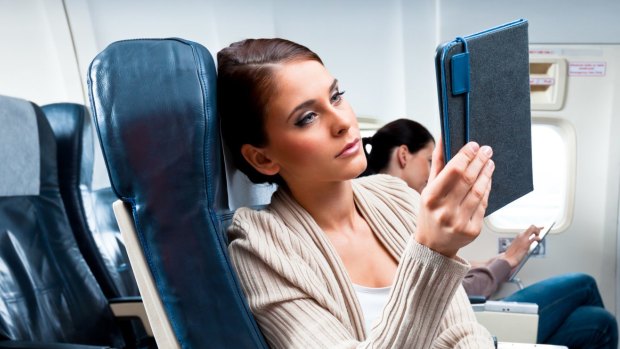This was published 7 years ago
Airline inflight entertainment: Seatback screens go as passengers use their own devices
By Christopher Mele

Customers are increasingly relying on their own tablets and smartphones for entertainment on airlines.Credit: iStock
Those seat-back screens that have long been part of in-flight entertainment systems are preparing to depart from many planes, experts say, and will gradually be replaced by content streamed to passengers' electronic devices through improved wireless service.
But as with a delayed flight, don't expect the changes to take off in a hurry.
For airlines, the switch would save money and cater to customers' changing viewing habits, which rely increasingly on tablets and smartphones, William Hoppe, the leader of travel, logistics and hospitality at Intelenet Global Services, said in an email.
Jon Cobin, the chief commercial officer at Gogo, which provides Wi-Fi service on more than 2,900 commercial planes, said in an email that "virtually everyone is connected at all times on the ground today."
"That behaviour doesn't change when you get in the air," he added.
With built-in screens, airliners provide passengers with a set menu of content through boxes that power the in-flight entertainment system. The screens appeared in their most primitive form in the late 1980s with a few movies played on a loop. By the early 2000s, they had advanced to allow passengers to make choices on demand.
By streaming content over wireless systems, passengers will have a wider array of content and the carriers will not have to maintain screens because passengers will bring their own portable devices on board.
Figures for how many planes are solely equipped to stream content were not available. But screens are "definitely decreasing in popularity," and most new plane models do not include them, Hoppe said.
Mergers and acquisitions have led to a hodgepodge of fleets with mixed approaches, Robert W. Mann Jr., an independent airline industry analyst and consultant, said in an email. Compounding the confusion is the pace of fleet makeovers, which can take up to three years.
By the time next-generation planes are in service, the technology on them will already headed for obsolescence, Jason Rabinowitz, the director of airline research for Routehappy - which among other things, tracks in-flight amenities - said in an interview.
"The thing with the airline industry is nothing happens quickly," Rabinowitz said. "The only thing that moves quickly is the aircraft itself."
For carriers that discontinue the screens, the savings can be significant. By one estimate, in-flight entertainment systems are the biggest expense in outfitting a new plane and can make up 10 per cent of the entire cost of an aircraft.
The screens and their wiring add weight to the plane, and when fuel prices are high, every pound makes a difference. Another financial incentive: Without the screens, carriers can install slimmer seats, which means they can accommodate more passengers and earn more money, Brett Snyder, the author of the airline industry blog "Cranky Flier," said in an interview.
Fans of the built-in screens can expect them to remain on long-haul international flights, while carriers with shorter domestic routes will be more inclined to drop them. Hoppe noted that carriers like Southwest Airlines had been promoting streaming content for eight years and had never purchased planes with seat-back screens.
"Rise of in-flight Wi-Fi aside, the zero screen purchases made by Southwest aligns with the fact that many of the carrier's flights are shorter in duration than the time it takes to finish a movie," he said.
Experts said that if airliners are going to rely on consumer electronics for in-flight entertainment, the carriers should be prepared to offer another amenity: outlets for passengers to charge their devices. Hoppe said it was "imperative" to have them available in all rows and seats, and "essential" to ensure that each one works.
"Being stuck in the seat with the malfunctioning charging outlet is the type of experience that can shape customer attitude towards the airline as a whole," he noted, "especially as the need to charge increases with more device activity."
Seat-back screens have drawn complaints that they cast too much light in a darkened cabin, and the bulky boxes below the seats that power the entertainment systems take up leg room and space for stowing carry-on luggage.
A drawback to streaming, however, is that airliners will not gain access to movies before they are released for home viewing. Carriers customarily get a jump on those films by a month or two, but because movie studios are highly protective of their content, they do not want to risk having anyone download a new release when it is streamed, Rabinowitz said. He added that about 90 per cent of passengers clicked on "new releases" on seat-back screens.
Snyder said he had seesawed in his feelings about streaming but had come down on the side of the screens.
"It is awesome to be able to watch television or a movie in the background while working on my laptop," he wrote in a blog post. "This is indeed a first-world problem. Can I be content without the screen? Sure. But I kind of want it to feel like it is when I'm at home. That makes me greedy, but hey, why not?"
The loss of seat-back screens should curb those questionable moments of in-flight etiquette when one passenger peeks at what a seatmate is watching, or more awkwardly, when a passenger watches something rife with sex and violence that may be inappropriate for others nearby.
"There's definitely a number of passengers who like to watch 'Game of Thrones,'" Rabinowitz said.
The New York Times
Sign up for the Traveller newsletter
The latest travel news, tips and inspiration delivered to your inbox. Sign up now.